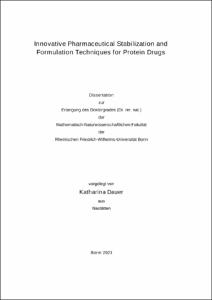Dauer, Katharina: Innovative Pharmaceutical Stabilization and Formulation Techniques for Protein Drugs. - Bonn, 2023. - Dissertation, Rheinische Friedrich-Wilhelms-Universität Bonn.
Online-Ausgabe in bonndoc: https://nbn-resolving.org/urn:nbn:de:hbz:5-73377
Online-Ausgabe in bonndoc: https://nbn-resolving.org/urn:nbn:de:hbz:5-73377
@phdthesis{handle:20.500.11811/11194,
urn: https://nbn-resolving.org/urn:nbn:de:hbz:5-73377,
doi: https://doi.org/10.48565/bonndoc-185,
author = {{Katharina Dauer}},
title = {Innovative Pharmaceutical Stabilization and Formulation Techniques for Protein Drugs},
school = {Rheinische Friedrich-Wilhelms-Universität Bonn},
year = 2023,
month = dec,
note = {Solid protein formulations for peroral, nasal or parenteral administration would significantly improve the therapeutic use, compliance, and stability of protein-based drugs. The aim of this work was to develop, apply, and assess innovative pharmaceutical stabilization and formulation techniques for protein drugs particularly to assess the suitability of small-scale HME approaches for the production of stable solid protein formulations. This thesis focuses on ram extrusion and TSE as techniques for the production of solid protein-loaded extrudates and VCM for predictive screening purposes. The stabilization of model proteins (lysozyme, BSA) and a peptide (human insulin) was achieved by embedding in dissolving (PEG 20,000) or eroding polymeric matrices (PLGA 50:50, EVA (40 % VA)). The work further aimed to evaluate the impact of process stress on protein stability enabling the comparison of different melt extrusion formulations and process parameters such as type of extruder, thermomechanical stress profiles, screw configurations, screw speed, and residence time distributions. Although proteins in solid state formulations exhibit an enhanced stability, the proteins can undergo degradation during processing and appropriate analytical methods were applied after processing: RP-HPLC (degradation products and chemical protein stability), SEC (monitoring protein aggregate formation or fragmentation), SEM-EDX (visual protein particle distribution), ss-DSC (polymer melting peaks and protein unfolding temperatures), ss-FTIR and CD spectroscopy (conformational protein stability), and biological activity assay. Since even small-scale HME processes require considerable amounts of material, VCM was implemented as a predictive screening tool to identify appropriate polymeric matrices prior to extrusion and to assess protein stability after thermal stress using only a few milligrams of protein powder. These findings were directly correlated with the results of protein-loaded extrudates prepared by ram extrusion or TSE. The gap towards a mechanistic understanding of the interactions between HME process variables and quality attributes were filled via numerical simulation. As 1D and 3D computational simulations were applied and combined with experimental data, results revealed a better understanding of HME process parameters on protein integrity. This provided an early starting point for the production of protein-loaded extrudates without negatively affecting the protein integrity and prior protein formulation development of long-term release systems by small-scale HME processing.},
url = {https://hdl.handle.net/20.500.11811/11194}
}
urn: https://nbn-resolving.org/urn:nbn:de:hbz:5-73377,
doi: https://doi.org/10.48565/bonndoc-185,
author = {{Katharina Dauer}},
title = {Innovative Pharmaceutical Stabilization and Formulation Techniques for Protein Drugs},
school = {Rheinische Friedrich-Wilhelms-Universität Bonn},
year = 2023,
month = dec,
note = {Solid protein formulations for peroral, nasal or parenteral administration would significantly improve the therapeutic use, compliance, and stability of protein-based drugs. The aim of this work was to develop, apply, and assess innovative pharmaceutical stabilization and formulation techniques for protein drugs particularly to assess the suitability of small-scale HME approaches for the production of stable solid protein formulations. This thesis focuses on ram extrusion and TSE as techniques for the production of solid protein-loaded extrudates and VCM for predictive screening purposes. The stabilization of model proteins (lysozyme, BSA) and a peptide (human insulin) was achieved by embedding in dissolving (PEG 20,000) or eroding polymeric matrices (PLGA 50:50, EVA (40 % VA)). The work further aimed to evaluate the impact of process stress on protein stability enabling the comparison of different melt extrusion formulations and process parameters such as type of extruder, thermomechanical stress profiles, screw configurations, screw speed, and residence time distributions. Although proteins in solid state formulations exhibit an enhanced stability, the proteins can undergo degradation during processing and appropriate analytical methods were applied after processing: RP-HPLC (degradation products and chemical protein stability), SEC (monitoring protein aggregate formation or fragmentation), SEM-EDX (visual protein particle distribution), ss-DSC (polymer melting peaks and protein unfolding temperatures), ss-FTIR and CD spectroscopy (conformational protein stability), and biological activity assay. Since even small-scale HME processes require considerable amounts of material, VCM was implemented as a predictive screening tool to identify appropriate polymeric matrices prior to extrusion and to assess protein stability after thermal stress using only a few milligrams of protein powder. These findings were directly correlated with the results of protein-loaded extrudates prepared by ram extrusion or TSE. The gap towards a mechanistic understanding of the interactions between HME process variables and quality attributes were filled via numerical simulation. As 1D and 3D computational simulations were applied and combined with experimental data, results revealed a better understanding of HME process parameters on protein integrity. This provided an early starting point for the production of protein-loaded extrudates without negatively affecting the protein integrity and prior protein formulation development of long-term release systems by small-scale HME processing.},
url = {https://hdl.handle.net/20.500.11811/11194}
}






